Introduction
The big question is, What’s Next? Corporate America is in an unprecedented situation here in 2020. We are all in this together, trying to answer What’s Next. Whether your workforce has already physically returned to the workplace, is returning soon, or is waiting until 2021, one common thread exists: the workplace will never be the same. Meyer has been regularly communicating with our corporate clients and our One Global Design partners in major international cities to continually find the answers to What’s Next?
Here are some topics that are being discussed, analyzed and strategized. Download Our PDF Guide
Leadership and Culture
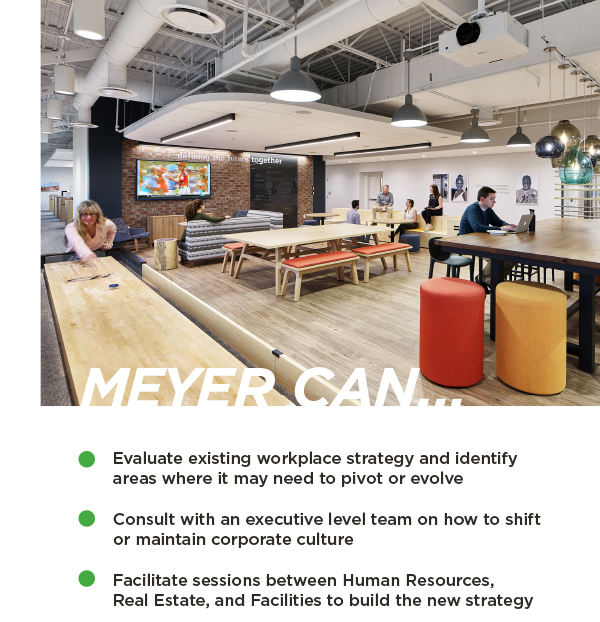 Companies have spent years and millions of dollars building their unique brands and fostering their individual cultures. The design of the physical office and the interactions it creates both shapes and supports a corporate culture, and it is the shared responsibility of Leadership, Human Resources, and Real Estate to maintain and encourage cultural growth.
Companies have spent years and millions of dollars building their unique brands and fostering their individual cultures. The design of the physical office and the interactions it creates both shapes and supports a corporate culture, and it is the shared responsibility of Leadership, Human Resources, and Real Estate to maintain and encourage cultural growth.
LEADERSHIP
- Diversity + Inclusion has risen as a top priority. Leaders need vision, passion, and commitment to make an impact.
- Access to leadership in these times is critical. Some companies have thrived while others have had to adjust.
- Leaders who are focused on meeting the needs of the employee first—emotional, physical, mental, technological—are seeing the highest employee approval ratings.
- Now more than ever, leaders are being forced to lead. Empathy has become a key leadership attribute.
CULTURE
- Workplace diversity and inclusion are top of mind these days and will only grow in importance as companies continue to invest in their diversity and inclusion programs.
- New strategies need to be developed to allow company culture to thrive when employees are not in the office.
- Human Resources, Real Estate, and Facilities Departments have to work together to collaboratively and cohesively support their company’s culture.
- Trust in employees to get their work done and contribute to the organization has been a quick lesson learned by companies.
Work from Anywhere
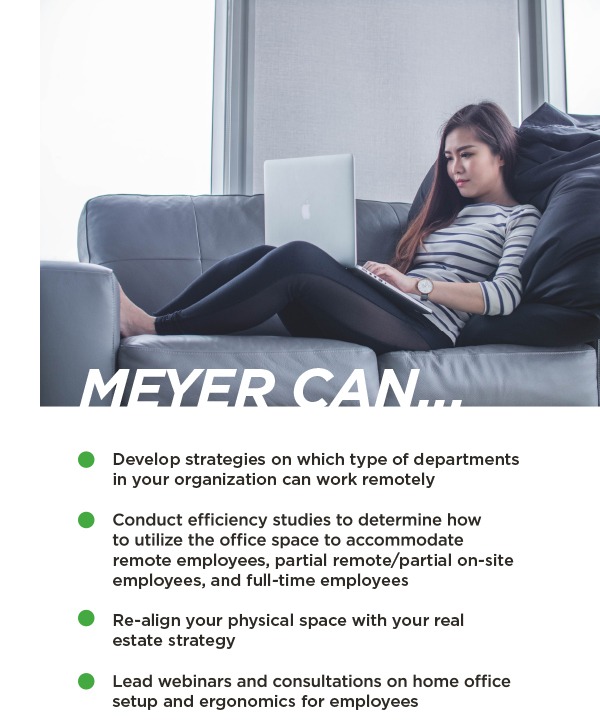 Companies have been pleasantly surprised at how well the workforce and the business could adapt to a mandated, immediate work from home policy. This shift has caused companies to pause and think about permanent alternative work strategies.
Companies have been pleasantly surprised at how well the workforce and the business could adapt to a mandated, immediate work from home policy. This shift has caused companies to pause and think about permanent alternative work strategies.
- Work from Home (WFH) has shifted to the global concept of Work From Anywhere (WFA).
- Companies are looking at which functions and departments can permanently work from anywhere, must be in the office, or can split their time between the two scenarios.
- New remote working strategies will impact seating assignments and the dynamics of office layouts.
- Future real estate strategies will need to be re-aligned with remote working strategies. Cost savings have the potential to be significant.
- Business travel and what is deemed necessary travel is under evaluation as technological improvements provide access to effective, virtual communication.
- Remote working strategies are still so new and have not been tested throughout a full business cycle. Companies are test driving strategies for 3/6/12 months before deciding upon their new normal.
- New policies and procedures need to be adopted for remote work protocol.
- Stipends are being given to remote employees for home office technology and ergonomics.
Innovation and Productivity
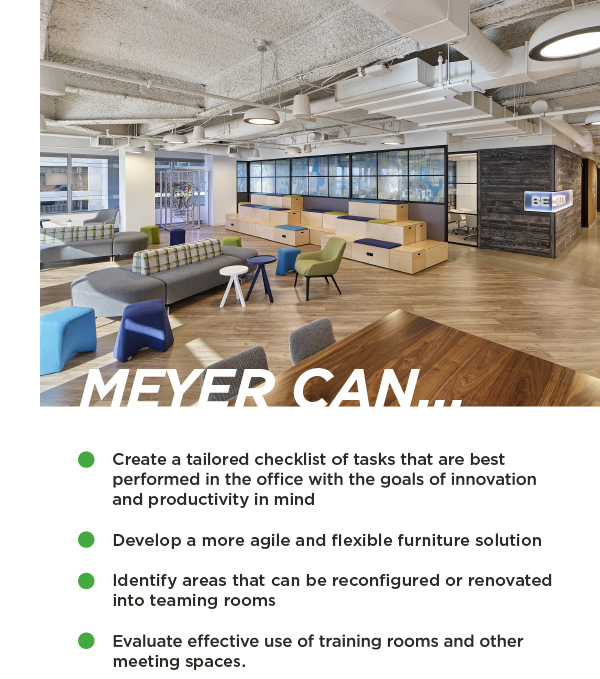 The physical office is here to stay, but how an office is used will evolve. As employees have now experienced a prolonged work from home situation, they are beginning to understand which tasks are best to do in a home or “heads down” environment and which tasks are best done in collaboration. Efficiency, productivity, and innovation are measuring sticks for this dual environment evaluation. The physical office space is most effective for teaming and collaboration based activities. Taking cues from the Agile Work Method, the use of dedicated teaming rooms will continue to rise.
The physical office is here to stay, but how an office is used will evolve. As employees have now experienced a prolonged work from home situation, they are beginning to understand which tasks are best to do in a home or “heads down” environment and which tasks are best done in collaboration. Efficiency, productivity, and innovation are measuring sticks for this dual environment evaluation. The physical office space is most effective for teaming and collaboration based activities. Taking cues from the Agile Work Method, the use of dedicated teaming rooms will continue to rise.
- The “in office” conversation evolves—what is your reason for being there and what are you there to accomplish?
- The essence of human connection during a meeting is being realized.
- Engagement between in-office and remote employees is critical. Fear of missing out is a lasting concern.
- Need for small conference and team rooms is increasing.
- Desk Sharing gains popularity. It reduces the footprint of square footage per employee and increases availability for collaborative space.
- Variety of options and autonomy of “choice” continue to empower employees.
- Large training activities will continue to trend virtually.
- Companies must do what is best for their organization. Make prescriptive choices that create lasting value.
Health and Wellbeing
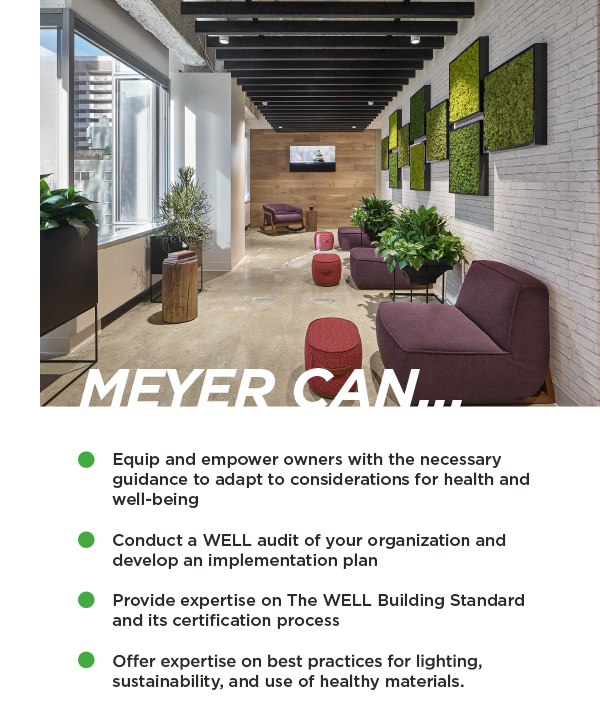 In recent years, there has been a surge in positive attitudes about health and wellbeing in workplace initiatives. However, many companies are slow to implement them. Understanding their benefits and using them could be the edge that an organization needs. Employee wellbeing doesn’t need to be costly as a minimal investment can produce effective results. Research has shown that there are many reasons why workplace wellness pays back. Of course, it is hard to calculate the payoff in monetary value, but you can measure the gains in your team’s performance and general wellbeing. Our environment contributes to holistic health and has a lot to do with how it supports humans physically, how we think, and how it promotes psychological health and safety. Here are some key topics of conversation to consider when it comes to health and wellbeing in the workplace:
In recent years, there has been a surge in positive attitudes about health and wellbeing in workplace initiatives. However, many companies are slow to implement them. Understanding their benefits and using them could be the edge that an organization needs. Employee wellbeing doesn’t need to be costly as a minimal investment can produce effective results. Research has shown that there are many reasons why workplace wellness pays back. Of course, it is hard to calculate the payoff in monetary value, but you can measure the gains in your team’s performance and general wellbeing. Our environment contributes to holistic health and has a lot to do with how it supports humans physically, how we think, and how it promotes psychological health and safety. Here are some key topics of conversation to consider when it comes to health and wellbeing in the workplace:
- WELL Building Standard vs wellness
- Curated architectural elements and amenities can provide opportunities to be more active within a space, such as interconnecting stairs and yoga areas.
- Through building improvements made by landlords and property owners, many workplaces are feeling the benefits of accessible outdoor spaces.
- Implementing biophilllic design concepts can increase an individual’s connection to nature.
- Mental health and wellbeing need to be better supported. Programs dedicated to bettering inclusivity and mindfulness can bring positive impacts to the workplace.
- An empathetic approach to workplace strategy can create psychological safety for employees.
Facilities Upgrades: Now is the Time
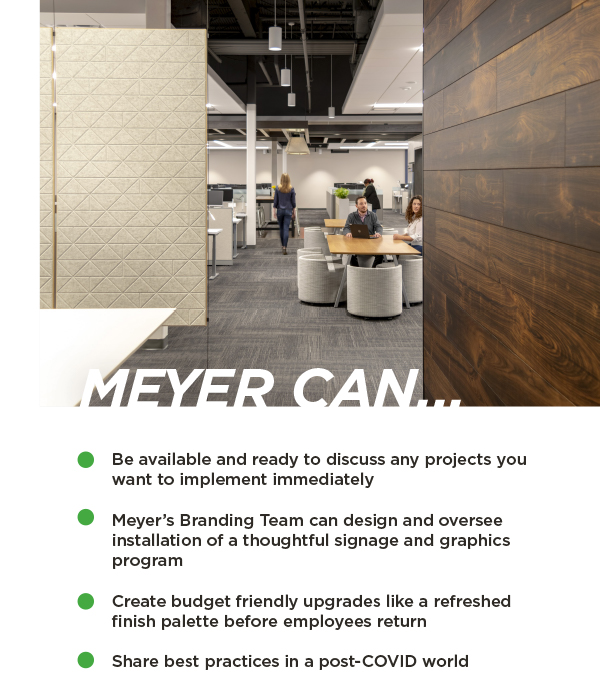 Now is the time to take advantage of a temporarily vacated building and provide a refreshed or rethought workplace for when your employees return to work. Running design and construction projects in an occupied building or campus is always a facilities manager’s biggest logistical challenge. Many companies are taking advantage of this “empty building” time to renovate, especially large volume spaces like cafeteria, parking lots, lobbies, restrooms, or workstation areas. While long term design solutions should not be swayed by the pandemic and social distancing trends, we can take some cues and lessons learned to design for a better, healthier future.
Now is the time to take advantage of a temporarily vacated building and provide a refreshed or rethought workplace for when your employees return to work. Running design and construction projects in an occupied building or campus is always a facilities manager’s biggest logistical challenge. Many companies are taking advantage of this “empty building” time to renovate, especially large volume spaces like cafeteria, parking lots, lobbies, restrooms, or workstation areas. While long term design solutions should not be swayed by the pandemic and social distancing trends, we can take some cues and lessons learned to design for a better, healthier future.
- Projects can be scheduled, designed, and built efficiently in 2020 with the right decision-making criteria in place.
- Large scale, long term renovations do not need to be heavily influenced by social distancing protocol.
- Short term adjustments for social distancing protocol should be thoughtful, flexible, and well designed.
- Good graphic design creates trust. Consider hiring a professional graphic design group (Meyer!) for re-entry campaigns and protocol
- Reimagine how your workplace can function better in the long term. Take hygiene cues from the pandemic and use them to address long-lasting habits such as integrating more touchless technology in cafes, restrooms, security, and materials that can be cleaned and sanitized better.
